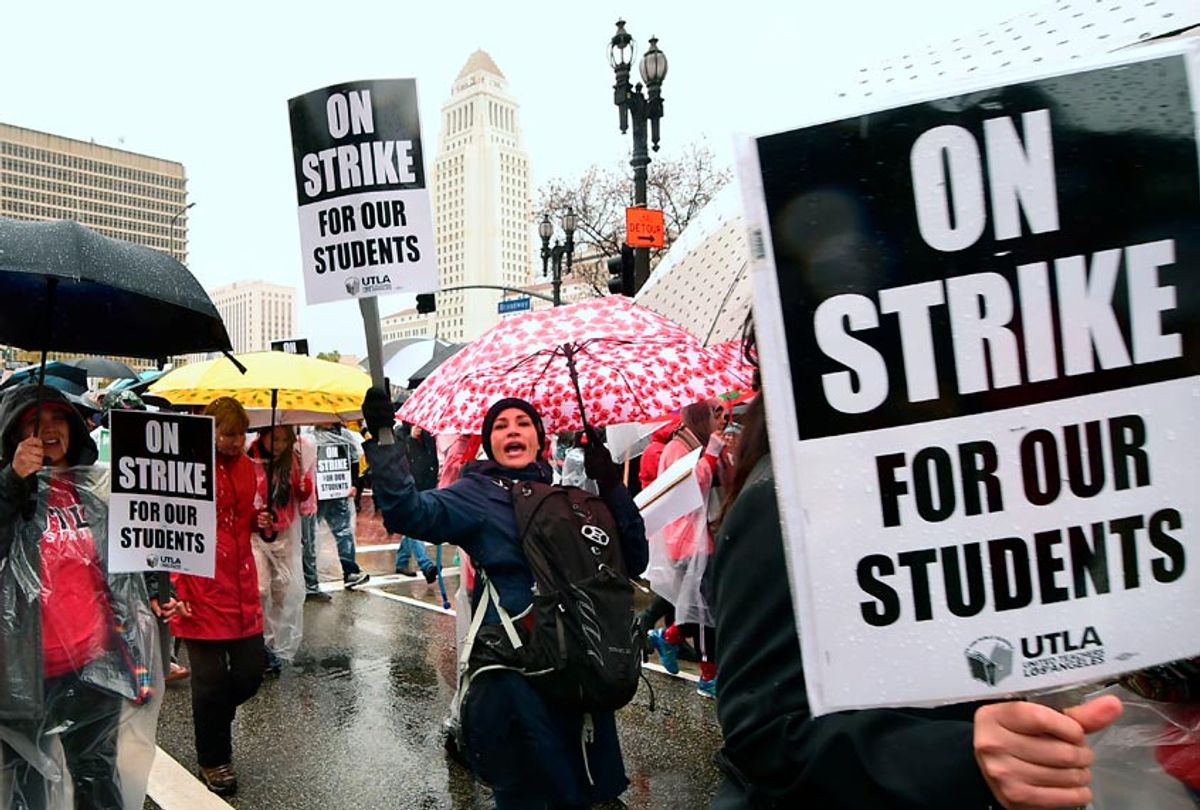Following a six-day teachers’ strike over inadequate public-school funding, United Teachers Los Angeles (UTLA) and the Los Angeles Unified School District (LAUSD) reached a tentative agreement Tuesday. While tallies haven’t yet been released, UTLA has confirmed that teachers voted in favor of the contract and, as of Wednesday, have returned to their classrooms.
The agreement, which was preceded by a nearly 21-month bargaining period, reverses some of the trends the union was protesting, including bloated class sizes, insufficient staffing of nurses and counselors, excessive standardized testing and a lack of resources for special education. (UTLA’s protests, including the strike, were largely the product of a reform movement among educational unions nationwide.)
It also calls for a greater reckoning with charter schools: publicly funded, privately operated schools boosted primarily by wealthy financiers and executives. UTLA members rebuke these schools for siphoning funding from public schools and view a pro-charter district agenda as the cause of the aforementioned problems.
The new contract would restrict school privatization, calling on California to establish a cap on charter schools. It also states that Los Angeles mayor Eric Garcetti will endorse the Schools and Communities First ballot initiative, which will ostensibly redirect $11 billion per year to California schools, community colleges, health clinics and other local institutions.
In These Times spoke to five teachers from five different LAUSD schools. While most of them contend that more could have been won, these rank-and-file members overwhelmingly consider the new terms an improvement and a testament to the power of strikes.
“I am pleased with the agreement for several reasons,” second-grade teacher and rank-and-file UTLA member Traci Rustin told In These Times. “I think we started a conversation about charter schools among those members of the community and UTLA who had not previously given it much thought.”
Rustin and some other teachers, however, found the vote bittersweet, arguing that while they’re eager to return to work, the proposed terms should have included more aggressive changes. The agreement prevents the district from “unilaterally ignor[ing]” all class sizes and promises a gradual reduction of class size — which routinely exceeds 40—over the next four years, imposing maximums of 39 students for English and math courses in secondary schools. While the change marks an improvement, some remain frustrated.
“There are classes with 45 students in them. Do we really think that 41 students, three years from now will be acceptable? Absolutely not!” a kindergarten teacher in West Los Angeles who wished to remain anonymous told In These Times. “I am glad that the school district cannot come in and change that on a whim, like they were initially trying to do. . . But the reduction isn't enough.”
The 2019-2020 school year will see additional full-time teacher librarians and counselors for secondary schools, and nurses for all schools. By the 2020-2021 school year, theoretically, each school will be equipped with one nurse, five days a week. In the 2014-2015 school year, California ranked below all other states in student-to-librarian ratios, while nearly 40 percent of LAUSD schools were staffed with a nurse only one day a week, according to UTLA.
Still, the proposed staff-to-student ratios continue to worry some. “I don't think that having a ratio of 500 students to one counselor is acceptable,” said the kindergarten teacher. “Yes, the district is giving us 17 more counselors to meet that ratio, finally, but a 500 to 1 ratio for mental health is not showing our students that we're there for them.”
“It’s a little disheartening to realize that we’ve gained no ground on school psychologists and librarians for elementary schools,” added fourth-grade teacher Anavelia Valencia.
To address the issue of rampant standardized testing, UTLA has also vowed to establish a committee with LAUSD to cut testing in half — a move teachers overwhelmingly approve. Teachers will also receive a retroactive raise of three percent for the 2017-2018 school year, as well as an additional three percent retroactive raise dating from July 1, 2018. While educators emphasize that their salaries are a low-level concern, the raises come at a time when many California teachers can scarcely afford to rent or buy a home, yet don’t qualify for public housing.
The contract also ensures a number of changes designed to bolster students’ wellbeing. Schools will curtail “random” searches of students—a practice that has elicited strong criticism for targeting and criminalizing Black, Latinx and Muslim students. Schools will also plan to replace some of their industrial environs—bungalows, asphalt—with plant life, which has been shown to have therapeutic effects. Furthermore, according to the agreement, the district will provide an attorney for immigrant families as part of an Immigrant Defense Fund initiative.
While teachers find many of these changes promising, the circumstances surrounding voting were somewhat contentious. Because UTLA teachers learned of the contract the same day they were expected to vote, “several members were upset about voting so quickly,” said Rustin. “I wouldn't have minded having an extra day to vote, but I also understand the need to return to work ASAP.” Relatedly, some organized impromptu meetings to discuss the contract and the merits of voting either way.
Whatever the outcome of the new terms, teachers agree much more work remains on the local, state and national levels — especially as educators in Denver and Oakland are preparing for potential strikes in response to public-school funding issues — and are returning to the classroom intent on keeping the struggle alive. In the meantime, they look forward to a fairer — and more galvanized — labor landscape. “The future of public education depends on making informed decisions about charter schools versus community schools,” said Rustin. “We were successful in calling attention to this.”
“Teachers have been beat down,” UTLA president Alex Caputo-Pearl said at a press conference on Tuesday night. “One of the things we’re most proud of is that this campaign… had our members say, ‘I deserve better.’”



Shares